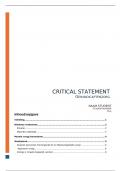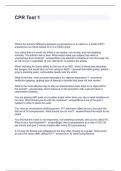Sustainable Business Management
Van Riel Karolien
, Deel 1: Introduction to sustainable business development
Sustainable business management: making business decisions with the purpose of creating value for
society so that future generations can meet their own needs, on an economic, social and
environmental level.
The Triple Bottom Line
The Global Ethical Trilemma – Economical
Beginning of 70’s: first awareness that economical growth couldn’t be unlimited.
80’s-90’s: technological revolution fueled the age of efficiency
21’st century: effects are more visible but has still a lot of work to do
The Global Ethical Trilemma – Economical
Social justice: the ability to live a worthy life -> equality income.
5% of the global population has as much income as 80%
The Global Ethical Trilemma – Environmental
The Kuznets curve: growing economies would lead to environmental degradation until the basic
needs of population are fulfilled, after this they behave more ‘green.’
In industrialized countries, we have more service-oriented businesses.
Green movement: Planetary boundaries are (close to being) overstepped. At this rate, we will
use “3 earths” per year by 2050 in terms of resources and waste disposal. (Now: 1,7 earth a year
today)
The Global Ethical Trilemma has 3 approaches:
Global Social-Democracy: create global economic order, improving the global common good.
Eco-efficient Capitalism: buying cleaner gars, creating a greener environment but no social
aspect considers (inequal circumstances for those who cannot afford cleaner cars)
Red-Green Planetarism: avoids emptying of resources, ensuring basic life quality for every
individual, where economic growth is seen as unsuccessful.
Carroll’s Pyramid has 4 responsibilities:
Economic responsibilities: creating income, paying their employes and suppliers and proving
goods and services (priority over sustainable business decisions)
Legal responsibilities: imposing measures and fines for companies who don’t comply, but
sustainable business management is not legal compliance (only ecological aspect of
sustainability)
Ethical responsibilities: decisions on green suppliers, investing in green technology, avoiding
suppliers who involve child labor (but depends like the child labor of Levi in India)
Discretionary/philanthropic: giving back to the world through charity, donations, or volunteering
by covering first their economic and legal responsibilities.
, Business ethics management: the management of ethical issues or problems a business and its
employees can encounter and the set of values, policies and practices that a company possesses to do
this.
Corporate governance: the system of rules, practices, and processes by which a company is directed
and controlled. Corporate governance essentially involves balancing the interests of a company’s
many stakeholders, such as shareholders, senior management executives, customers, suppliers,
financiers, the government, and the community.
Deel 2: From priority to prosperity
The traditional economic flow model gives an overview of all the flows of money that are going
around in the economy. The different actors in the economy are pictured, who interact by
exchanging money.
Different actors
Households: provide labor, capital, and nature, pay for goods and services, and receive income,
pay taxes, and save money.
Businesses: Create goods and services, sell these goods nationally and internationally, invest and
receive funds to support their growth.
Government: Collects taxes from households and businesses, invests, spend, and provide public
goods.
Financial markets and institutions: Provide loans and invest in businesses, funds to the
government in case of a budgetary deficit.
International markets: Sell and buy goods and services to/from national businesses and
households, invest in national businesses.
Shortcomings in the limits to economic growth model
Not all transactions in the economy involve (involve) money.
It‘s created on a social island.
It does not take into account where resources come from.
Gross Domestic Product: the total added value of all goods and services created in a country in a
specific period of time.
Shortcomings of GDP:
- The GDP per capita forgets about inequality, not every citizen has equal access.
- The GDP is calculated based on market prices, doesn’t tell real added value created in a country.
- The growth of the GDP is a self-fulfilling prophecy, all political decisions are based on the
expectation that GDP will always grow in the long term.
- The GDP does not measure happiness, workers in a higher GDP country have less free time
Easterlin paradox:
Within a society, rich people tend to be much happier than poor people.
Rich societies tend not to be happier than poor societies (or not by much).
As countries get richer, they do not get happier (comparing each other situation).
External effects: costs or profits created by a market transaction that causes involuntary negative or
positive effects on a third party that is not directly involved in that transaction and therefore does not
pay or receive compensation for those effects. Where there are additional costs involved, the external
effects are considered negative, when there is a profit, the external effects are considered positive.









